

However, what occurs between these two stages?
Learn what your child is going through during this important stage of finding their self-identity. And how you, as a parent, can do your part in helping them.
Risk-taking and teenagers - ReachOut Parents. This can help if you: are wondering 'why do teenagers take risks?

' think your child takes problematic or negative risks want to learn about positive risk-taking. Common risky behaviour in teenagers. Emotional and Social Development in Adolescence. What you’ll learn to do: describe adolescent identity development and social influences on development Adolescence is a period of personal and social identity formation, in which different roles, behaviors, and ideologies are explored.
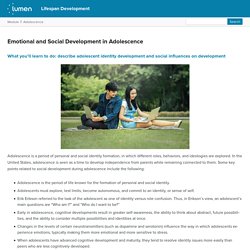
In the United States, adolescence is seen as a time to develop independence from parents while remaining connected to them. Some key points related to social development during adolescence include the following: Adolescence is the period of life known for the formation of personal and social identity.Adolescents must explore, test limits, become autonomous, and commit to an identity, or sense of self.Erik Erikson referred to the task of the adolescent as one of identity versus role confusion. Understanding Emotion in Adolescents: A Review of Emotional Frequency, Intensity, Instability, and Clarity - Natasha H. Bailen, Lauren M. Green, Renee J. Thompson, 2019. Adolescence is a time of transition from childhood to adulthood during which people experience significant changes in almost all areas of their life, including biological functioning, cognitive capabilities, social environments, and family and peer relationships (Heller & Casey, 2016; Larson & Sheeber, 2008).

Puberty is associated with significant hormonal changes that give rise to physical maturation and influence a variety of behaviors, including those associated with aggression and sexuality (Buchanan, Eccles, & Becker, 1992). The prefrontal cortex of the brain undergoes change and growth via the myelination and synaptic pruning process (Steinberg, 2005). Beginning in early adolescence, formal operational thought begins to replace concrete operations, allowing for more complex thoughts, information processing, and reasoning (Rosenblum & Lewis, 2003).
The developmental changes that adolescents experience also extend to their social lives. Identity vs. Role Confusion in Erikson's Theory. Identity versus confusion is the fifth stage of ego according to psychologist Erik Erikson's theory of psychosocial development.
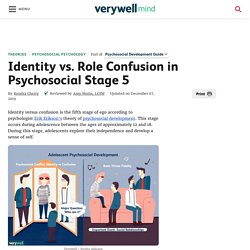
This stage occurs during adolescence between the ages of approximately 12 and 18. During this stage, adolescents explore their independence and develop a sense of self. According to Erikson, people progress through a series of stages as they grow and change throughout life. Erik Erikson and Self-Identity - Child Development Theory: Adolescence (12-24) According to Erik Erikson, a prominent developmental theorist of the 1950's, youth must resolve two life "crises" during adolescence.
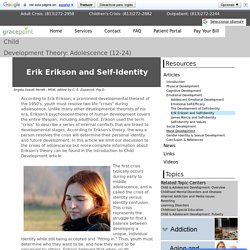
Unlike many other developmental theorists of his era, Erikson's psychosocial theory of human development covers the entire lifespan, including adulthood. Erikson used the term "crisis" to describe a series of internal conflicts that are linked to developmental stages. According to Erikson's theory, the way a person resolves the crisis will determine their personal identity and future development. Adolescent Identity Development: What to Expect in Teens. Adolescent Identity Development: The Factors of Change Among the profound and exciting changes taking place in adolescence is the process of self-discovery.
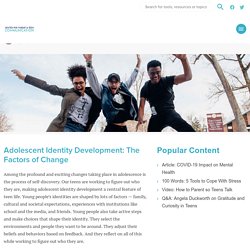
Our teens are working to figure out who they are, making adolescent identity development a central feature of teen life. Lifespan Development. Learning Outcomes Describe changes in self-concept and identity development during adolescenceExplain Marcia’s four identity statuses Psychosocial Development.
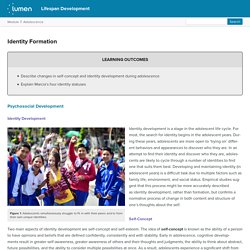
Adolescent Identity Development - Adolescence - ACT for Youth. The development of a strong and stable sense of self is widely considered to be one of the central tasks of adolescence [1].
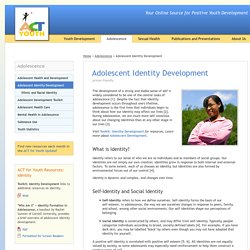
Despite the fact that identity development occurs throughout one's lifetime, adolescence is the first time that individuals begin to think about how our identity may affect our lives [2]. During adolescence, we are much more self-conscious about our changing identities than at any other stage in our lives [3]. Visit Toolkit: Identity Development for resources. Learn more about Adolescent Development. Why Is Teen Identity Development Important? Though it can be hard for parents to let go and acknowledge their teen needs external help, a credible adventure therapy program can relatively quickly and positively change your son or daughter’s life for the better.
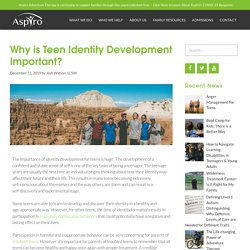
Psychologist Erik Erikson advocated that teen identity development is fostered by experiences that allow individuals to express their individuality and receive feedback and validation from others. Adventure therapy programs provide experiences that promote healthier relationships and positive identity formation in teens. Teenage Self-Identity Issues: Causes, Problems, And Common Behaviors. While there are a variety of ways that teens experience identity formation, some experiences can become very harmful to the individual.

In the sections below, we discuss the causes and more serious issues in teenage identity issues & development and how parents can help. Common Causes Contributing to Unhealthy Teen Identity Development The importance of identity development for teens is huge. Five Ways to Help Teens Feel Good about Themselves. No one wants to hang out with me. I’m a failure at school. All my other friends seem happy.
What’s wrong with me? Supportive parenting and teenagers - ReachOut Parents. Despite wanting to be a supportive parent to your child, you may feel like you’ve just had the door closed in your face and you’ve got it all wrong. Your relationship will be changing and starting to become more equal as they grow up and you spend more time apart. This doesn’t mean you can’t stay connected and provide the support they need as they go through this process of becoming a whole new person, an adult. This can help if you:
Does family shape our identity? There are two ways that families influence values and expectations of their children: directly and indirectly. Parents directly teach their children values. This includes teaching right and wrong, religious education, teaching about interacting with people, and rules and expectations. Indirectly, parents teach and socialize their children by example. Children watch their parents interact with others, make choices and determine right and wrong for themselves, and this impacts how they develop their moral self.